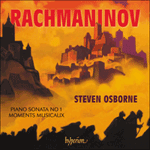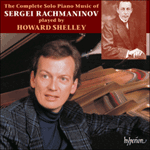
Welcome to Hyperion Records, a British classical label devoted to presenting high-quality recordings of music of all styles and from all periods from the twelfth century to the twenty-first.
Hyperion offers both CDs, and downloads in a number of formats. The site is also available in several languages.
Please use the dropdown buttons to set your preferred options, or use the checkbox to accept the defaults.

| Steven Osborne (piano)» More |
In contrast to the other two pieces Rachmaninov composed in 1917, the Oriental sketch is a vigorous and good-humoured piece in the manner of a toccata. This was also the only piece of the three that Rachmaninov performed, giving the premiere in 1931, followed by a recording and finally publication in 1938. The somewhat inappropriate title was added by the publisher, leading Rachmaninov’s violinist friend Fritz Kreisler to quip that it should have been called ‘The Orient Express’. The incessant motoric movement does indeed hint at the train genre explored by the early modernists. The idioms of the languorous Russo-Oriental style that Rachmaninov inherited from Rimsky-Korsakov are still there, but buried deep, only making a tentative breakthrough in the middle section, where a haunting little phrase soars over the temporarily subdued clatter of the engine, lending the piece a greater elegance and depth.
from notes by Marina Frolova-Walker © 2022
L’Esquisse orientale est une pièce énergique et joviale, à la manière d’une toccata. C’est aussi la seule des trois pièces que joua Rachmaninov: il la créa en 1931, puis l’enregistra et finalement la publia en 1938. Le titre quelque peu inapproprié fut ajouté par l’éditeur, ce qui mena l’ami de Rachmaninov, le violoniste Fritz Kreisler, à dire avec esprit qu’elle aurait dû s’appeler «L’Orient Express». Le mouvement moteur incessant fait en effet allusion au genre ferroviaire exploré par les premiers modernistes. Les langages du langoureux style russo-oriental que Rachmaninov hérita de Rimski-Korsakov sont encore là, mais enfouis profondément, ne faisant qu’une percée timide dans la section centrale, lorsqu’une petite phrase lancinante s’élève au-dessus du cliquetis momentanément contenu de la locomotive, ce qui donne à cette pièce davantage d’élégance et de profondeur.
extrait des notes rédigées par Marina Frolova-Walker © 2022
Français: Marie-Stella Pâris
Im Gegensatz zu den beiden anderen Stücken ist die Orientalische Skizze ein lebhaftes und fröhliches Stück im Stil einer Toccata. Es war dies auch das einzige der drei Stücke, welches Rachmaninow aufführte—1931 gab er die Premiere, worauf eine Aufnahme und 1938 schließlich die Veröffentlichung folgten. Der etwas unpassende Titel wurde vom Verleger hinzugefügt, woraufhin der mit Rachmaninow befreundete Geiger Fritz Kreisler bemerkte, das Werk hätte „Orient-Express“ heißen sollen. Die ununterbrochene motorische Bewegung verweist tatsächlich auf das Zug-Genre, das von den Komponisten der frühen Moderne ausgelotet wurde. Die Charakteristika des schmachtenden russisch-orientalischen Stils, den Rachmaninow von Rimskij-Korsakow geerbt hatte, sind immer noch zugegen, wenn auch tief vergraben—erst im Mittelteil kommen sie zaghaft zum Vorschein, wenn sich eine eindringliche kleine Phrase über das vorübergehend gedämpfte Rattern der Lokomotive erhebt und dem Stück eine größere Eleganz und Tiefe verleiht.
aus dem Begleittext von Marina Frolova-Walker © 2022
Deutsch: Viola Scheffel
 Rachmaninov: Piano Sonata No 1 & Moments musicaux Rachmaninov: Piano Sonata No 1 & Moments musicaux‘Rachmaninov fans won’t want to miss this’ was Gramophone’s verdict on Steven Osborne’s Études-tableaux, and this thrilling release is an equally essential acquisition. Osborne proves a predictably fine exponent of the Faustian Piano Sonata No 1, ...» More |
 Rachmaninov: The Complete Solo Piano Music Rachmaninov: The Complete Solo Piano Music‘A fine achievement from Howard Shelley and Hyperion alike. These superbly recorded, idiomatic readings demonstrate Shelley's virtuoso pianism and aff ... ‘A significant testimony to Howard Shelley's artistry. Pianistically impeccable, he understands what Rachmaninov was about’ (Gramophone)» More |

